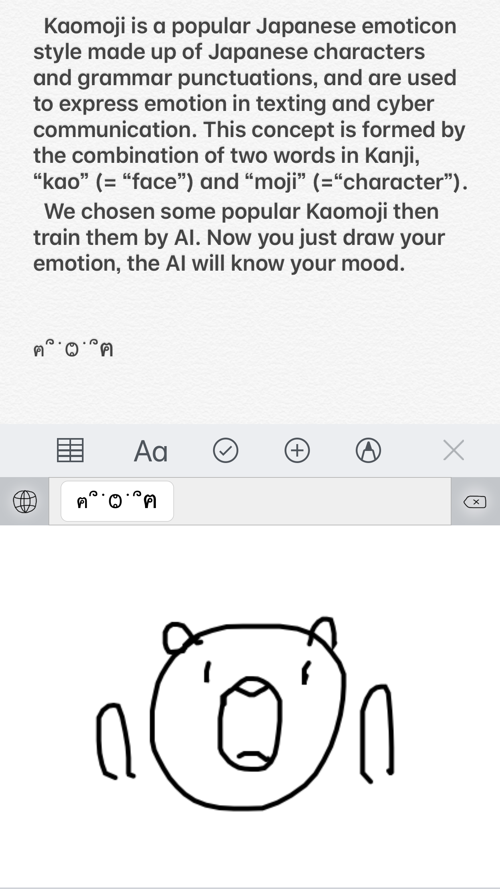


Traditionally, the symbol of heart – ♡ is used for denoting love in all cultures. In this case, the Japanese are no different from the Americans or Russians, except that they added a few of their characters to the heart. For example, symbols ノ~ ♡ represent the air kiss if used together with the heart. In addition, the Orientals use “chu” word to depict a kiss. The Japanese believe that this is what our “smack”, “mwah”, and “kisses” sound like in their language.
Feb 05, 2021 Hangouts even used to support SMS messaging, though that’s been removed over the past year to refocus the app for business users primarily. Still, despite the change in audience, Hangouts is the perfect app for anyone looking to talking or messing with their friends, family, and loved ones around the world. Kaomoji (顔文字) is a popular Japanese emoticon style made up of Japanese characters and grammar punctuations, and are used to express emotion in texting and cyber communication. The word kaomoji is also synonymous to be referred to as Japanese emoticons.This concept is formed by the combination of two words in Kanji, “kao” (顔 – “face”) and “moji” (文字 – “character”). More kaomoji, text font generators and changes coming right up! Some of you guys might have already noticed new additions to this site a while ago. We have a bunch of text font generators available (calligraphy / fraktur style, tiny Read more →.
Kaomoji emoticons are similar to smileys, but they often incorporate Japanese characters. While they originated in Japan, Kaomoji emoticons are now used in many other countries as well. Because of the wide range of characters available, Kaomoji smileys can be used to express emotions, actions, and characters with more detail than traditional. Kaomoji Lover Mac OS Lifestyle. Own Wish Buy Buy. Meet the best collection of Kaomoji (顔文字)! Use cute kaomoji on Twitter, Facebook, while others can do nothing but wonder how you made these lovely kaomoji! Easy to access from your menubar, at any time, just copy & paste, and have fun!
Kaomoji Love
If you study the selection of kaomoji depicting love, you can note that there are a lot of symbols in the form of a star * and o letter. Japan’s youth uses them to depict blush. These symbols are often used together with ノ, ノ, /, , and ヽ symbols. The slanted lines are intended to represent the hand covering the smiley’s face due to embarrassment. Together with the “hands”, symbols in the form of “ε” are also used to depict the mouth as if a person puckers up their lips for a kiss. Such kaomoji are usually sent to someone they want to hug and kiss. There is a joke among Japanese girls that these emoticons resemble perverts very much.
Kaomoji Sending Love
| (ノ´ з `)ノ | (♡μ_μ) |
| (♡-_-♡) | ( ̄ε ̄@) |
| (─‿‿─)♡ | (´。• ᵕ •。`) ♡ |
| (´ ω `♡) | ♡( ◡‿◡ ) |
| (ღ˘⌣˘ღ) | (♡°▽°♡) |
| (´• ω •`) ♡ | (´ ε ` )♡ |
| ╰(*´︶`*)╯♡ | (*˘︶˘*).。.:*♡ |
| (≧◡≦) ♡ | (⌒▽⌒)♡ |
| ♡ (˘▽˘>ԅ( ˘⌣˘) | ( ˘⌣˘)♡(˘⌣˘ ) |
| σ(≧ε≦σ) ♡ | ♡ (⇀ 3 ↼) |
| (˘∀˘)/(μ‿μ) ❤ | ❤ (ɔˆз(ˆ⌣ˆc) |
| Σ>―(〃°ω°〃)♡→ | (´,•ω•,)♡ |
| ( ´ ∀ `)ノ~ ♡ | (。・//ε//・。) |
| ♡ ~('▽^人) | ( ´ ▽ ` ).。o♡ |
| (っ˘з(˘⌣˘ ) ♡ | ٩(♡ε♡)۶ |
| (°◡°♡) | (*^^*)♡ |
| ヽ(♡‿♡)ノ | (*♡∀♡) |
| (◕‿◕)♡ | ♡(。- ω -) |
| (´。• ω •。`) ♡ | (♡˙︶˙♡) |
| (*¯ ³¯*)♡ | (/^-^(^ ^*)/ ♡ |
| ♡ ( ̄З ̄) | (´♡‿♡`) |
| ☆⌒ヽ(*'、^*)chu | (/▽\*)。o○♡ |
| ♡\( ̄▽ ̄)/♡ | (❤ω❤) |
